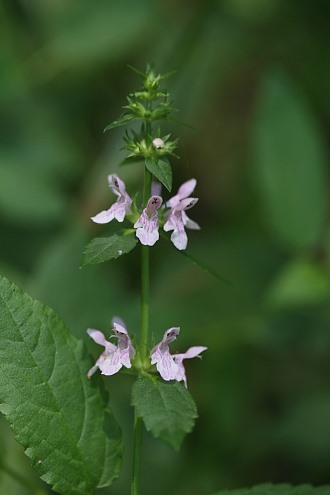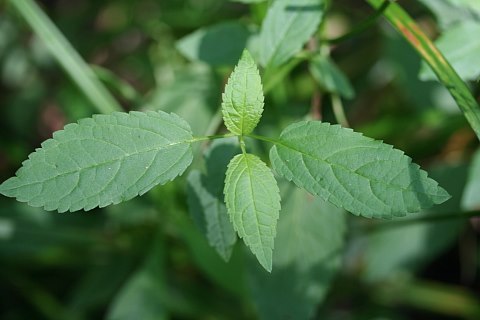Description:
This herbaceous perennial plant is ½–2½' tall and usually unbranched.
The
central stem is 4-angled, usually with scattered hairs along the
ridges, but not the sides (see Stem
Photo). The opposite leaves are up to 3½" long and 1" across.
They are usually lanceolate or narrowly ovate, with serrate or crenate
margins. The petioles of the lower leaves are about ¼" or slightly
longer, while the upper leaves have shorter petioles or are sessile.
Both the upper and lower
surfaces of the leaves are hairless or nearly so – if hairs are
present, they are most likely to occur along the lower mid-vein of the
leaves. The central stem terminates in a spike-like inflorescence that
has whorls of flowers at intervals along its length. This inflorescence
can vary from 2-8" in length. The tubular corolla of each flower is
about 1/3" long and divided into 2 lips. The hairy upper lip functions
as a protective hood, while the lower lip is divided into 3 lobes (a
central lobe and two smaller side lobes), which functions as a landing
pad for visiting insects. The flowers are light pink or white, often
with rosy pink splotches within the throat. The green calyx is hairless
and at least half as long as the tube of the corolla (not including the
lips). It is divided into 5 triangular segments that curl outward as
the ovaries mature. The blooming period occurs during the summer and
lasts about 1-2 months. Each flower is replaced by 4 black nutlets that
are oblong in shape. The root system consists of a taproot and
rhizomes. This plant often forms vegetative colonies, like many other
members of the Mint family.
across.
They are usually lanceolate or narrowly ovate, with serrate or crenate
margins. The petioles of the lower leaves are about ¼" or slightly
longer, while the upper leaves have shorter petioles or are sessile.
Both the upper and lower
surfaces of the leaves are hairless or nearly so – if hairs are
present, they are most likely to occur along the lower mid-vein of the
leaves. The central stem terminates in a spike-like inflorescence that
has whorls of flowers at intervals along its length. This inflorescence
can vary from 2-8" in length. The tubular corolla of each flower is
about 1/3" long and divided into 2 lips. The hairy upper lip functions
as a protective hood, while the lower lip is divided into 3 lobes (a
central lobe and two smaller side lobes), which functions as a landing
pad for visiting insects. The flowers are light pink or white, often
with rosy pink splotches within the throat. The green calyx is hairless
and at least half as long as the tube of the corolla (not including the
lips). It is divided into 5 triangular segments that curl outward as
the ovaries mature. The blooming period occurs during the summer and
lasts about 1-2 months. Each flower is replaced by 4 black nutlets that
are oblong in shape. The root system consists of a taproot and
rhizomes. This plant often forms vegetative colonies, like many other
members of the Mint family.
Cultivation:
The preference is partial sun and moist conditions. This plant also
tolerates light shade and full sun. The soil should contain sufficient
organic material to retain moisture. If this plant dries out, the
leaves have a tendency to turn yellow or brown, and the entire plant
may die.
Range & Habitat:
Smooth Hedge Nettle occurs in most counties of Illinois (see Distribution
Map), where it is native. This plant is occasional in
southern and central Illinois, but
uncommon or absent in the northern counties. Habitats include ravines
in floodplain forests, moist meadows along rivers or woodlands,
thickets, and various kinds of wetlands, including swamps, seeps, and
ditches. It can be found in either high quality habitats or rather
degraded sites.
Faunal Associations:
Primarily long-tongued bees pollinate the flowers, where they seek
nectar primarily. Short-tongued bees sometimes collect pollen, while
flower flies feed on the pollen, but they are not very effective
pollinators. Occasionally butterflies or skippers may visit the
flowers, but they aren't very effective at pollinating the flowers
either. The bitter foliage of this and other Stachys spp.
is not often consumed by mammalian herbivores.

Photographic
Location:
A swampy area of Busey Woods in Urbana, Illinois.
Comments:
This is a typical member of the Mint family. It is easy to overlook,
because this Hedge Nettle sp. tends to be rather small-sized and
non-descript, almost looking like a lanky Prunella vulgaris
(Self-Heal) at first glance. Identifying Smooth Hedge Nettle correctly
can be rather tricky, so here are some of the key features to look for:
1) The calyx is hairless; 2) the petioles of the lower leaves are
usually ¼" or longer, and 3) there are hairs on the ridges of the
4-angled central stem, but not on the sides. There is also a hairy form
of this plant, referred to as Stachys tenuifolia hispida
by some authorities and Stachys hispida by others,
that also occurs in Illinois. It has foliage that is more hairy, and
there are also some hairs along the edges of the calyx of each flower.
However, it is similar to Smooth Hedge Nettle in that the central stem
has hairs along the ridges, but not on the sides.